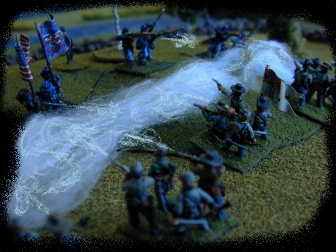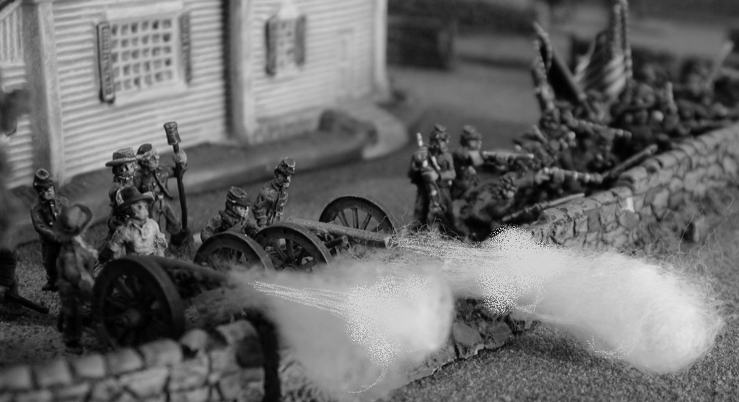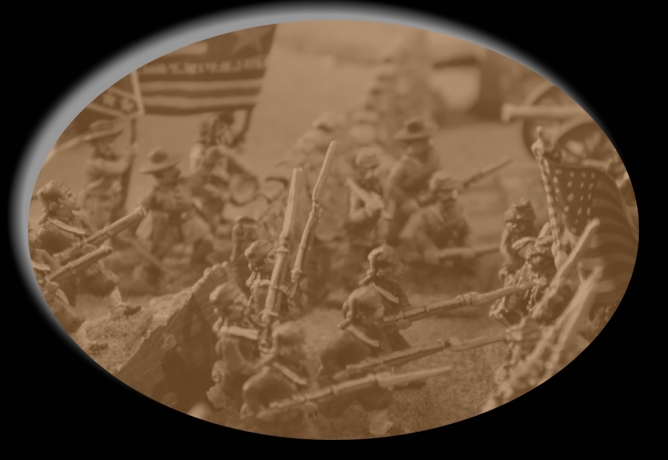
The battle of "Three Crossings" Pennsylvania,

One of the first periods I became interested in after my initial historical wargaming foray with micro armor was 15 mm American Civil War using "Johnny Reb II" rules. For dozens and dozens of battles and years it was the passion of myself and my fellow gamers. I painted all of Stonewall Jackson's division and then some for the South. Then I started with union figures, after a brigade of union figures my gaming interest moved into World War II and remained there for many years. I have since gone into several other periods the largest in the latest being 28 mm Victorian science fiction and colonial battles.
Having some time off lately my good friend Steve Gausche and I wanted to do a battle during the week while our wives were at work! After some thought I finally said "hey, how about we dust off our Civil War figures and give it a go! Steve was all for it!
After some thought while setting up the battlefield the night before I wanted to do something a little different than the standard meet them in the middle Civil War battle, as different thoughts crossed my mind Gettysburg came up. I thought to myself what would've happened if the South had won that day. I had the beginning of my scenario.
After the smoke clears over Gettysburg the South finds itself in possession of the battlefield with the Northern armies fleeing in disorder towards Washington. Although they have won the Confederate Army has not done it without paying a price. Thousands upon thousands of men lie dead and wounded upon the battlefield and many of the South's best divisions are wrecked. As Lee and his generals go about reorganizing the Army General Longstreet and cavalry general Jeb Stuart beg general Lee to pursue quickly the beaten Union forces and force an end to the war at the Gates of Washington. Lee agrees in principle that this is a great opportunity but also realizes that his army is strewn about and for the most part in no shape for a chase. He also knows that he is far from his supply bases and could be cut off in a moment. In the end he agrees to let Longstreet take Jeb Stuart's cavalry and nearly a division of infantry that were uncommitted or only partially committed at Gettysburg and still very fresh. He tells Longstreet to pursue the Union Army and try to keep them off balance until he can reorganize the rest of the Army and bring it up for a March on Washington.
Longstreet and Stewart chased the retreating Union Army towards Washington. Union troops, at least some of them, rallied by their armies better junior officers begin to get reorganized and brought back in to line just east of the river crossing near the Delaware border. Abraham Lincoln has also authorized the stripping of some of Washington's defenses to the form a blocking force at this point. Our battle opens at this river crossing. Jeb Stuart still smarting from his dressing down by Lee on his failure to use his cavalry to properly scout for the Army at Gettysburg has done a much better job this time. He reports back to Longstreet that Union troops are rallying and fortifying the town of Mills Crossing and surrounding area of the bridge. He tells Longstreet that an attack now would surely take the town and the crossing but that other reports tell him of more fresh Union soldiers seen coming from the direction of Washington on the roads east of town. Stuart also brings information from a southern sympathizer that there is a ford close to town and that his men are scouting for it now. General Lee called Longstreet to his tent the night before Longstreet left Gettysburg and told him that it might be wise to take along one of the Army's pontoon bridges, Longstreet protested that it would slow him down. Lee calmly told them that moving slower would be better for his troops should they have to fight a battle at the end of their march and that he doubted whether the battered Union Army would be moving very fast either. As he gazed at the river now General Longstreet thought to himself "that old gray fox, he knew I'd need this Bridge", now it was to be an ace up his sleeve. Longstreet decides to camp for the evening and attack with all his forces first thing in the morning. If he can capture the bridge and town and hold it until Lee advances the way will be open to Washington and the end of the war will be in sight.
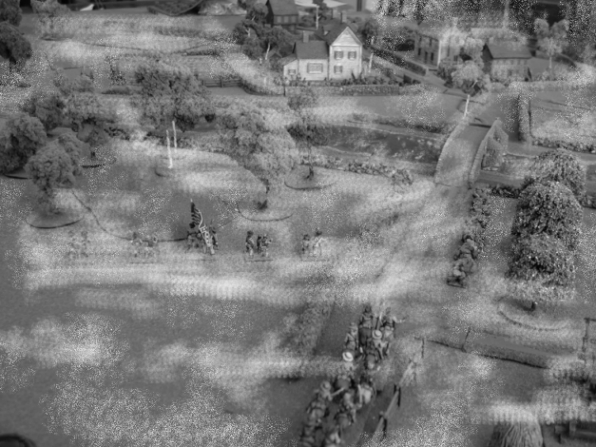 Our battle opened up just before dawn and in heavy fog. There was two
turns of darkness and four turns of fog.
Our battle opened up just before dawn and in heavy fog. There was two
turns of darkness and four turns of fog.
Jeb
Stewarts Calvary scouts its way to the river through the early morning fog and
darkness. Hidden movement and hidden placement of some troops was used at this
stage. You might be able to pick out union positions along the stone wall near
town. These positions were already known to Stewart from the previous nights
scout. The 1st Virginia cavalry presses up the road towards the bridge with a
second group of dismounted confederate cavalry in skirmish order advancing on the
left. This cavalry will encounter Union skirmishers hidden on the small wooded hill at
the left.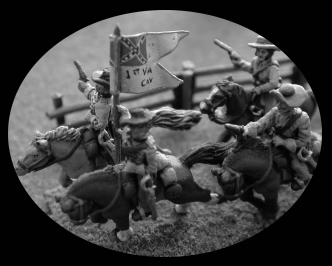
Finding their way in the darkness surrounded by banks of river fog the Confederate cavalry brushes up against union pickets and small skirmishes break out, Stewart sends messengers back to Longstreet and dismounts his cav, brings up his horse artillery and pushes the light union force back across the river. Doing this reveals the ford!, another messenger off to Longstreet to inform him of this crossing point. As the cav pushes the union skirmishers across the river they see union infantry in the light of the misty dawn manning hasty works and a stretch of stone wall running the length of the village. To cover their friends the union guns open up on the Cavalry, soon to the CSA horse guns unlimber and a lively dual begins across the river.
